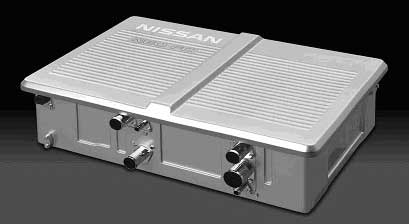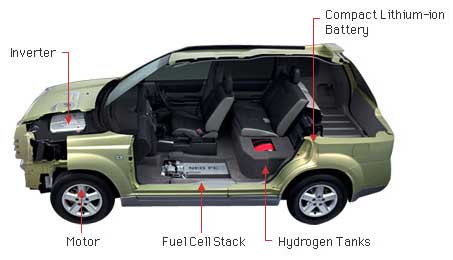Nissan X-Trail FCV
Nissan X-Trail FCV
The Nissan X-Trail FCV hydrogen vehicle is coming of age since Nissan has finally developed its own fuel cell stack to power this SUV. The 2003 model of the Nissan X-Trail FCV contained a polymer electrolyte type fuel cell stack manufactured by UTC Fuel Cells (USA). The 2005 X-Trail FCV, however, contains Nissan’s newest fuel cell coupled with a state-of-the-art high-pressure hydrogen storage system (10,000 psi), improving both performance and driving range.
 Nissan X-Trail FCV Hydrogen Vehicle – Photo Courtesy Kevin Kantola |
Improvements to the new fuel cell stack compared with the old stack include a reduction in volume by 60-percent, upgraded electrodes doubling the service life of the stack and expanded operational temperature range. The new hydrogen storage cylinder developed by Dynetek industries of Calgary, Canada, increases storage capacity by 30-percent without any change to the storage device’s dimensions. The H2 storage cylinder is made from an outer layer of carbon fiber wrapped around an inner aluminum liner.
 Nissan’s Own Fuel Cell Stack |
The 2005 Nissan X-Trail FCV hydrogen vehicle has a top speed of approximately 90 mph with a range of over 311 miles. The high-power electric motor comes in at 90 kw or 1.7 times that of its 2002 predecessor. The motor receives its power from a Compact Lithium-ion Battery, featuring a thin, laminated cell, which has half the weight and volume of a conventional battery, yet 1.5 times the output.
 |
Nissan Canada will be testing the X-Trail FCV around the Greater Vancouver area. The Nissan X-Trail FCV was already approved by the Japanese Minister of Land, Infrastructure and Transport in 2002 and began a limited leasing program in Japan in 2003. In the same year, Nissan joined the California Fuel Cell Partnership (CaFCP).
Written by Hydro Kevin Kantola
Leave a Reply
You must be logged in to post a comment.